TOYOTA RAV4 EV 2014 1.G Quick Reference Guide
Manufacturer: TOYOTA, Model Year: 2014, Model line: RAV4 EV, Model: TOYOTA RAV4 EV 2014 1.GPages: 52, PDF Size: 1.69 MB
Page 11 of 52
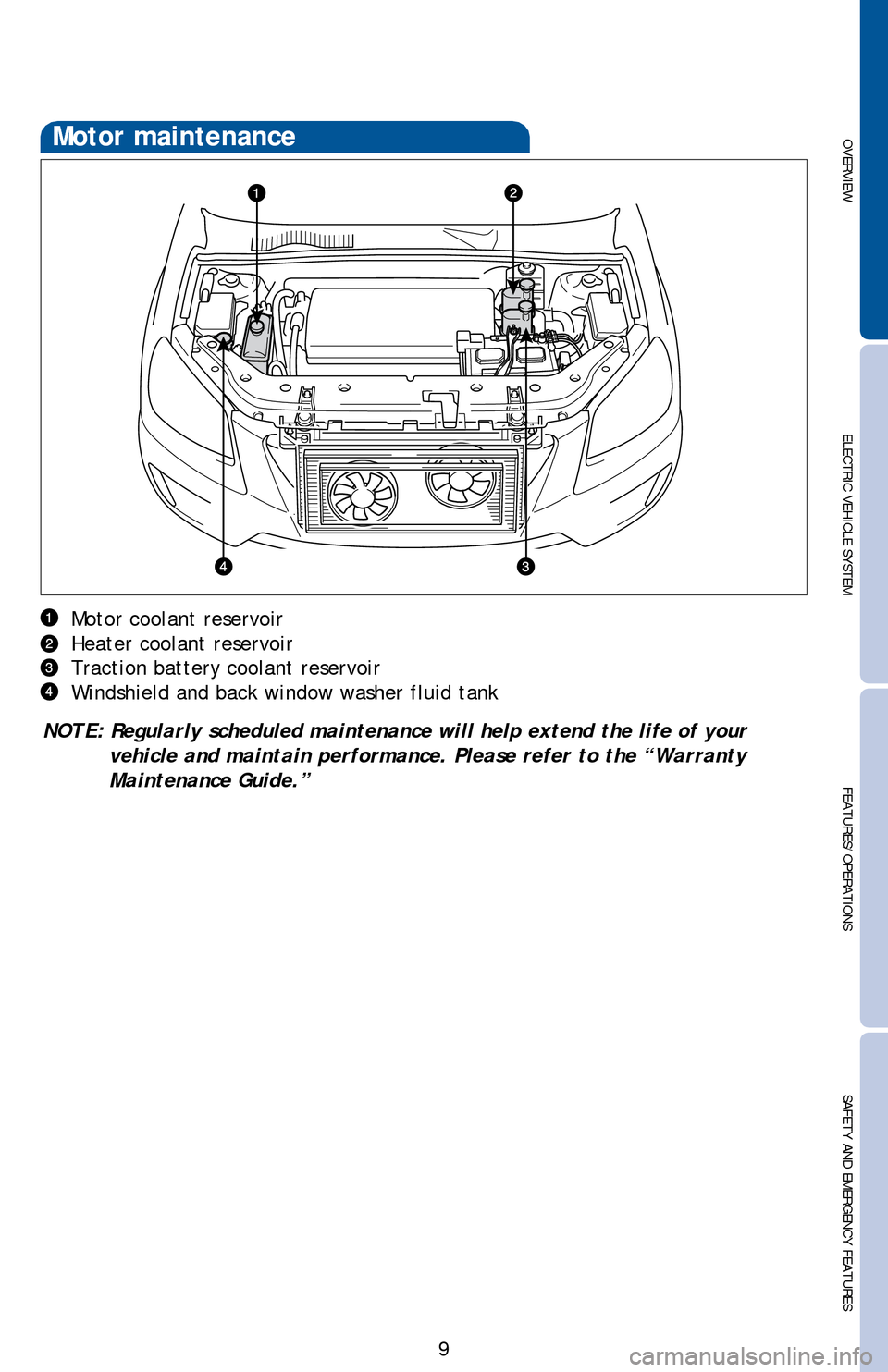
OVERVIEW ELECTRIC VEHICLE SYSTEMFEATURES/OPERATIONS
SAFETY AND EMERGENCY FEATURES
9
Motor coolant reservoir
Heater coolant reservoir
Traction battery coolant reservoir
Windshield and back window washer fluid tank
NOTE: Regularly scheduled maintenance will help extend the life of your
vehicle and maintain performance. Please refer to the “Warranty
Maintenance Guide.”
Motor maintenance
Page 12 of 52
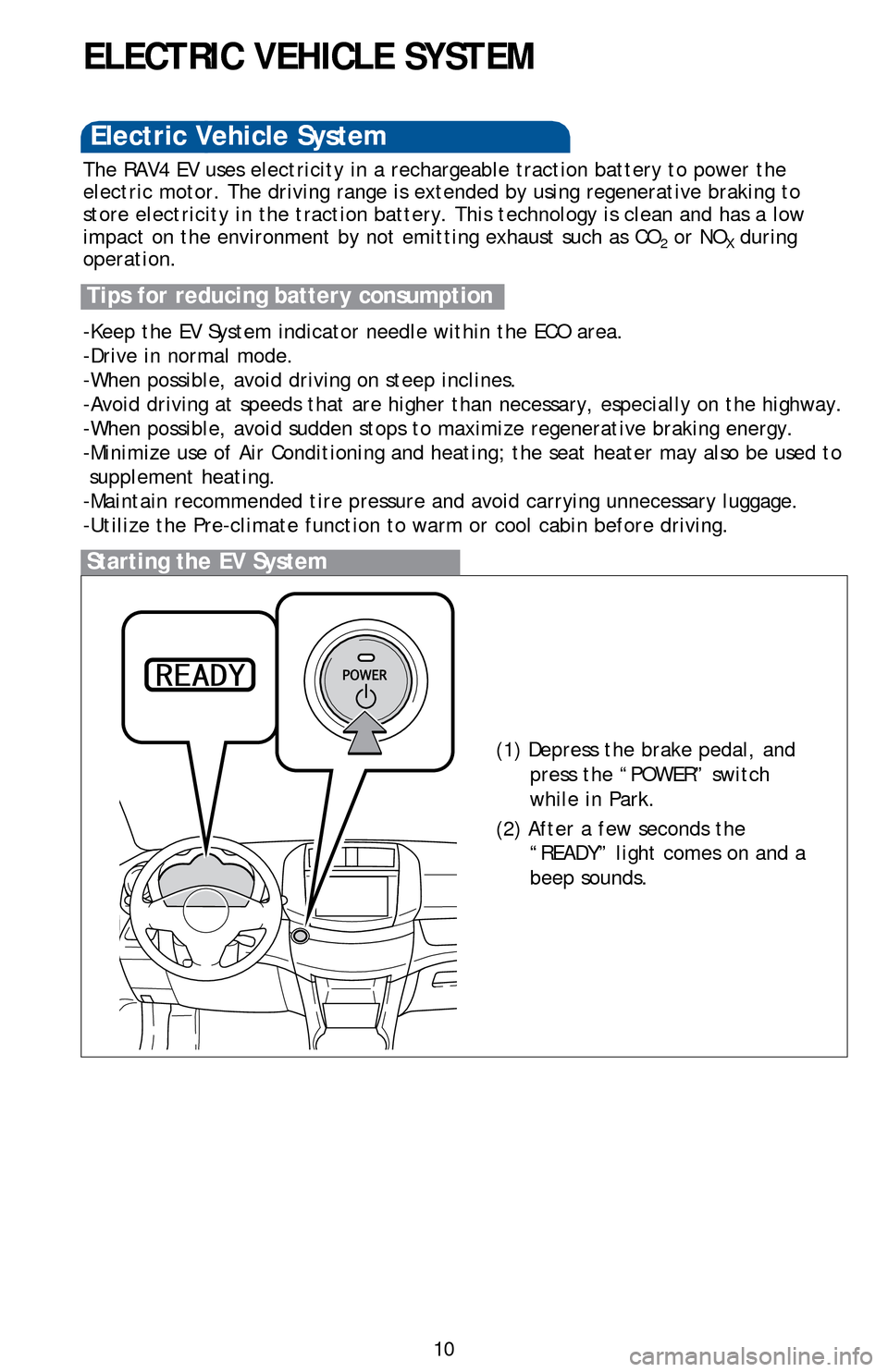
10
ELECTRIC VEHICLE SYSTEM
Starting the EV System
The RAV4 EV uses electricity in a rechargeable traction battery to power the
electric motor. The driving range is extended by using regenerative braking to
store electricity in the traction battery. This technology is clean and has a low
impact on the environment by not emitting exhaust such as CO
2 or NOX during
operation.
Tips for reducing battery consumption
-Keep the EV System indicator needle within the ECO area.
-Drive in normal mode.
-When possible, avoid driving on steep inclines.
-Avoid driving at speeds that are higher than necessary, especially on the highway.
-When possible, avoid sudden stops to maximize regenerative braking energy.
-Minimize use of Air Conditioning and heating; the seat heater may also be used to
supplement heating.
-Maintain recommended tire pressure and avoid carrying unnecessary luggage.
-Utilize the Pre-climate function to warm or cool cabin before driving.
Electric Vehicle System
(1) Depress the brake pedal, and
press the “POWER” switch
while in Park.
(2) After a few seconds the
“READY” light comes on and a
beep sounds.
Page 13 of 52
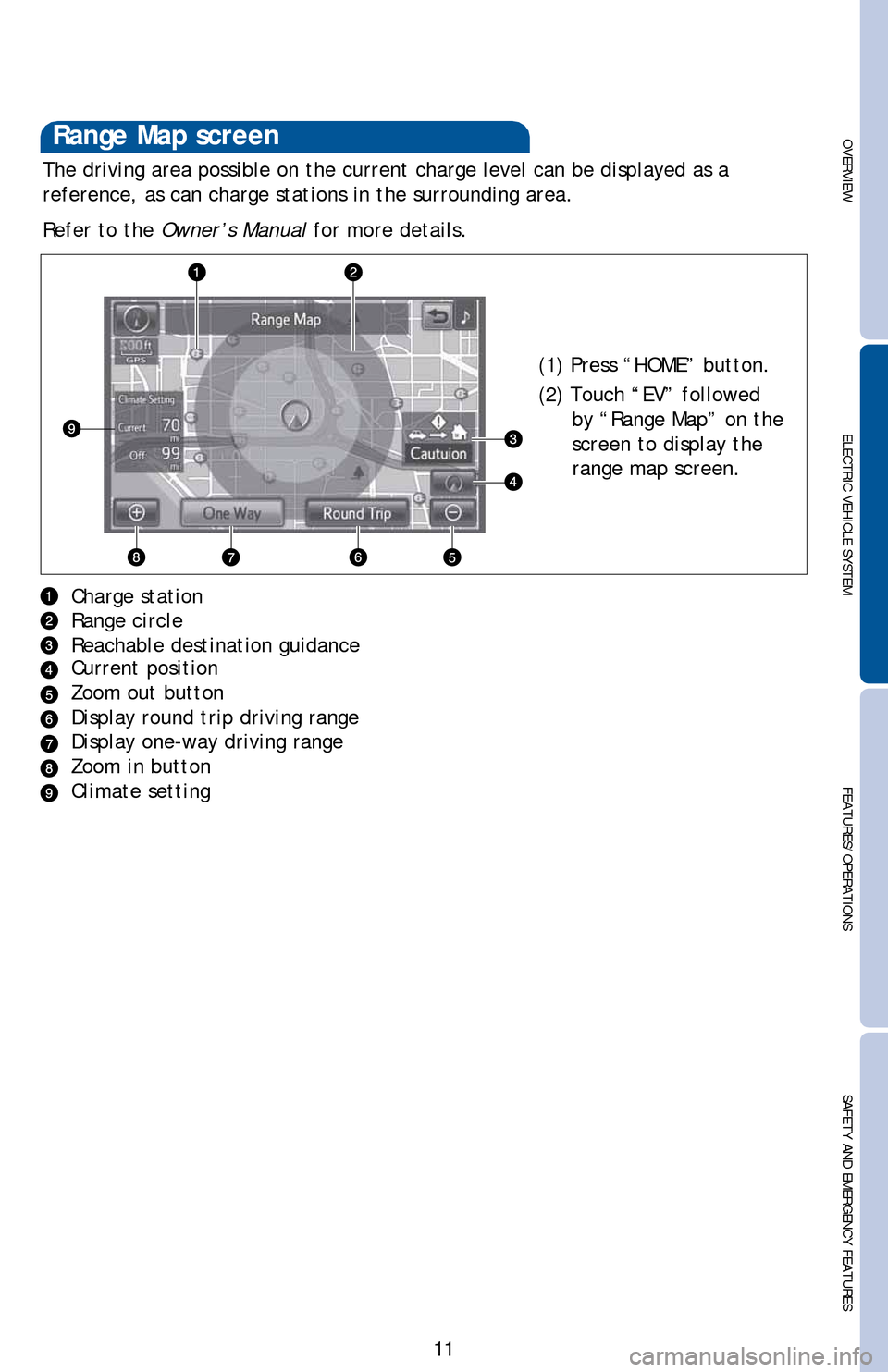
OVERVIEW ELECTRIC VEHICLE SYSTEMFEATURES/OPERATIONS
SAFETY AND EMERGENCY FEATURES
11
Range Map screen
The driving area possible on the current charge level can be displayed as a
reference, as can charge stations in the surrounding area.
Refer to the Owner’s Manual for more details.
(1) Press “HOME” button.
(2) Touch “EV” followed
by “Range Map” on the
screen to display the
range map screen.
Charge station
Range circle
Reachable destination guidance
Current position
Zoom out button
Display round trip driving range
Display one-way driving range
Zoom in button
Climate setting
Page 14 of 52
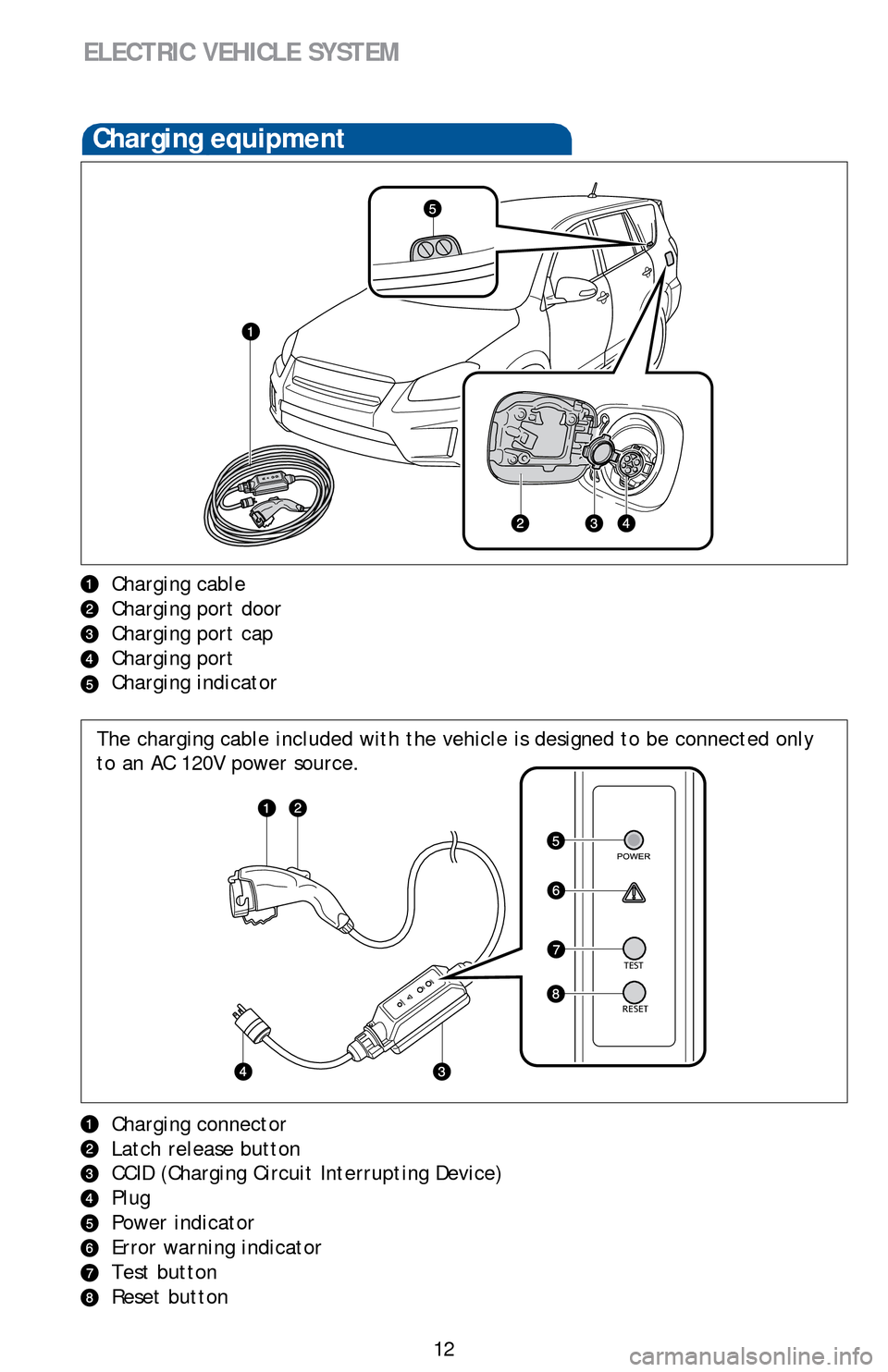
12
ELECTRIC VEHICLE SYSTEM
Charging cable
Charging port door
Charging port cap
Charging port
Charging indicator
Charging equipment
Charging connector
Latch release button
CCID (Charging Circuit Interrupting Device)
Plug
Power indicator
Error warning indicator
Test button
Reset button
The charging cable included with the vehicle is designed to be connected only
to an AC 120V power source.
Page 15 of 52
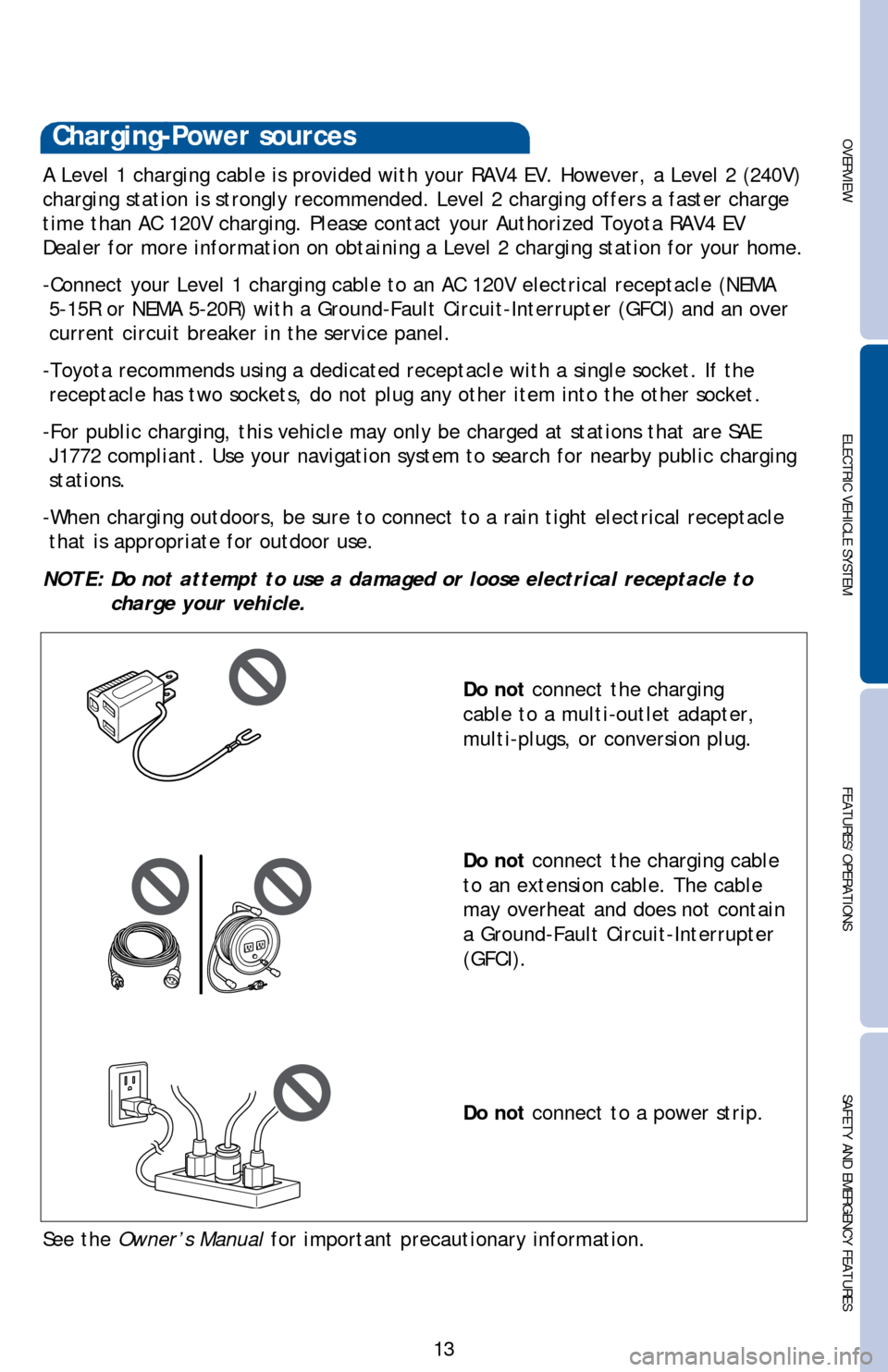
OVERVIEW ELECTRIC VEHICLE SYSTEMFEATURES/OPERATIONS
SAFETY AND EMERGENCY FEATURES
13
Charging-Power sources
A Level 1 charging cable is provided with your RAV4 EV. However, a Level 2 (240V)
charging station is strongly recommended. Level 2 charging offers a faster charge
time than AC 120V charging. Please contact your Authorized Toyota RAV4 EV
Dealer for more information on obtaining a Level 2 charging station for your home.
-Connect your Level 1 charging cable to an AC 120V electrical receptacle (NEMA
5-15R or NEMA 5-20R) with a Ground-Fault Circuit-Interrupter (GFCI) and an over
current circuit breaker in the service panel.
-Toyota recommends using a dedicated receptacle with a single socket. If the
receptacle has two sockets, do not plug any other item into the other socket.
-For public charging, this vehicle may only be charged at stations that are SAE
J1772 compliant. Use your navigation system to search for nearby public charging
stations.
-When charging outdoors, be sure to connect to a rain tight electrical receptacle
that is appropriate for outdoor use.
NOTE: Do not attempt to use a damaged or loose electrical receptacle to
charge your vehicle.
Do not connect the charging
cable to a multi-outlet adapter,
multi-plugs, or conversion plug.
Do not connect the charging cable
to an extension cable. The cable
may overheat and does not contain
a Ground-Fault Circuit-Interrupter
(GFCI).
Do not connect to a power strip.
See the Owner’s Manual for important precautionary information.
Page 16 of 52
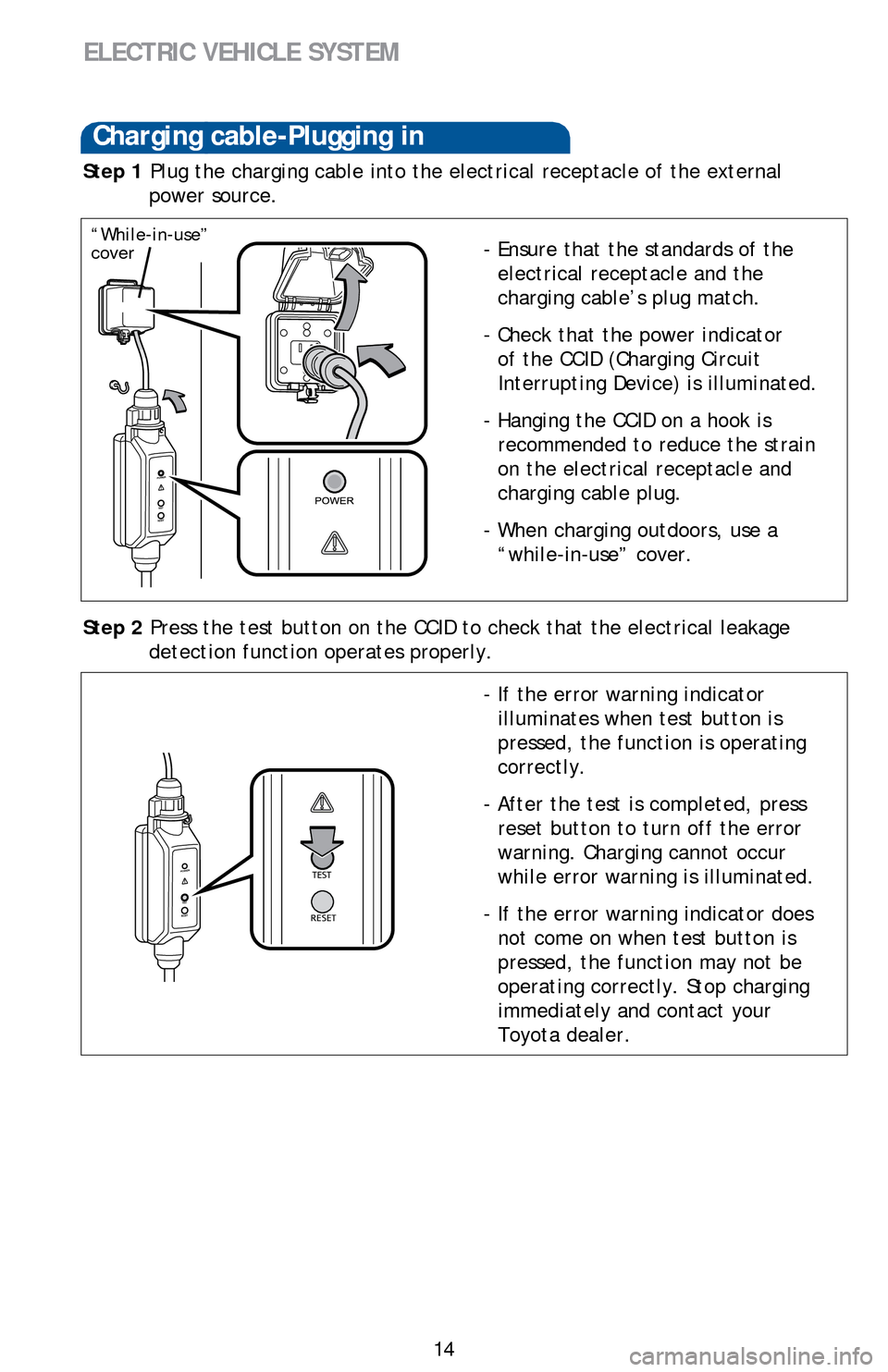
14
ELECTRIC VEHICLE SYSTEM
Charging cable-Plugging in
Step 1 Plug the charging cable into the electrical receptacle of the external
power source.
- Ensure that the standards of the
electrical receptacle and the
charging cable’s plug match.
- Check that the power indicator
of the CCID (Charging Circuit
Interrupting Device) is illuminated.
- Hanging the CCID on a hook is
recommended to reduce the strain
on the electrical receptacle and
charging cable plug.
- When charging outdoors, use a
“while-in-use” cover.
Step 2 Press the test button on the CCID to check that the electrical leakage
detection function operates properly.
- If the error warning indicator
illuminates when test button is
pressed, the function is operating
correctly.
- After the test is completed, press
reset button to turn off the error
warning. Charging cannot occur
while error warning is illuminated.
- If the error warning indicator does
not come on when test button is
pressed, the function may not be
operating correctly. Stop charging
immediately and contact your
Toyota dealer.
“While-in-use”
cover
Page 17 of 52
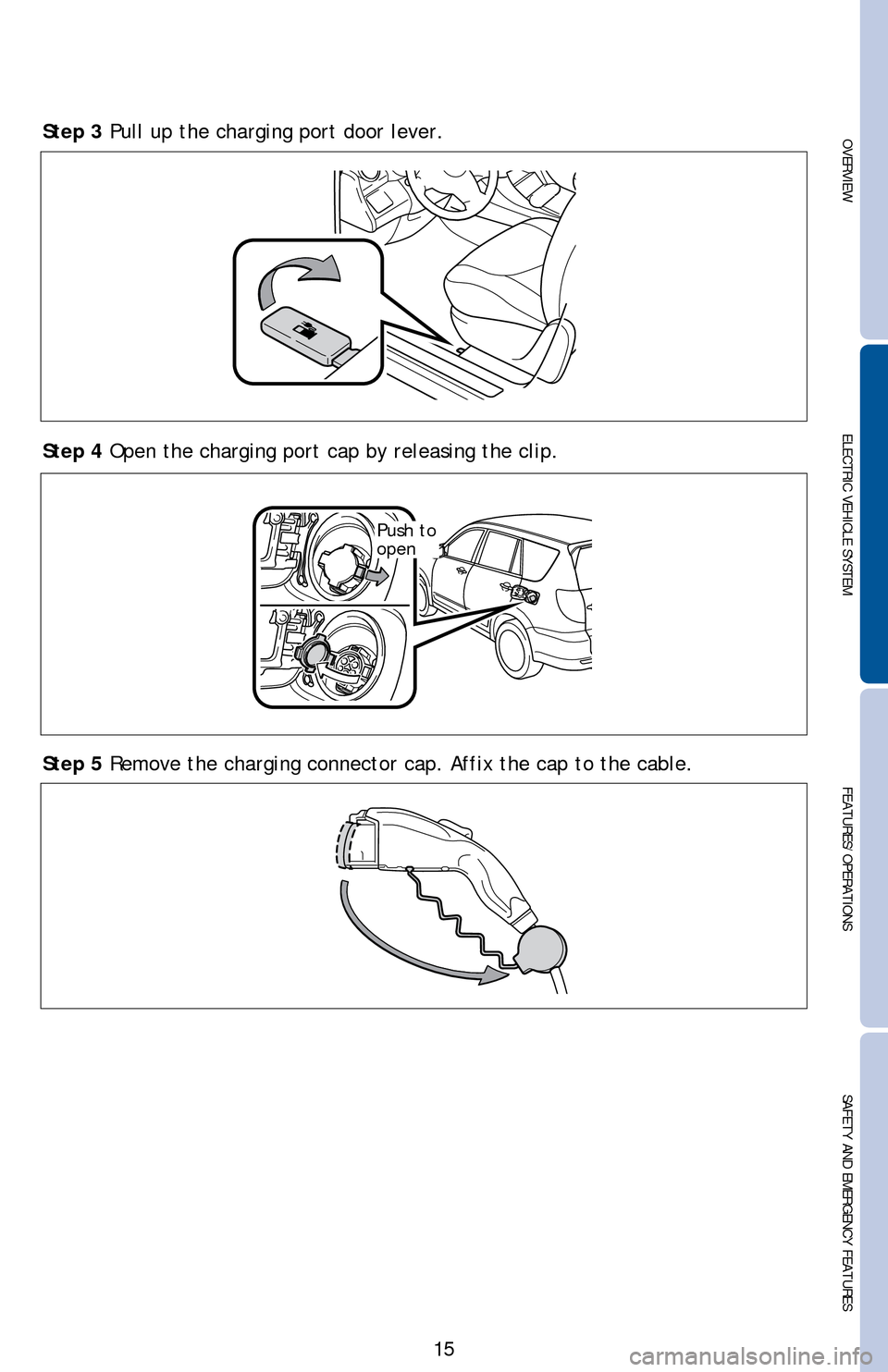
OVERVIEW ELECTRIC VEHICLE SYSTEMFEATURES/OPERATIONS
SAFETY AND EMERGENCY FEATURES
15
Step 3 Pull up the charging port door lever.
Step 4 Open the charging port cap by releasing the clip.
Step 5 Remove the charging connector cap. Affix the cap to the cable.
Push to
open
Page 18 of 52
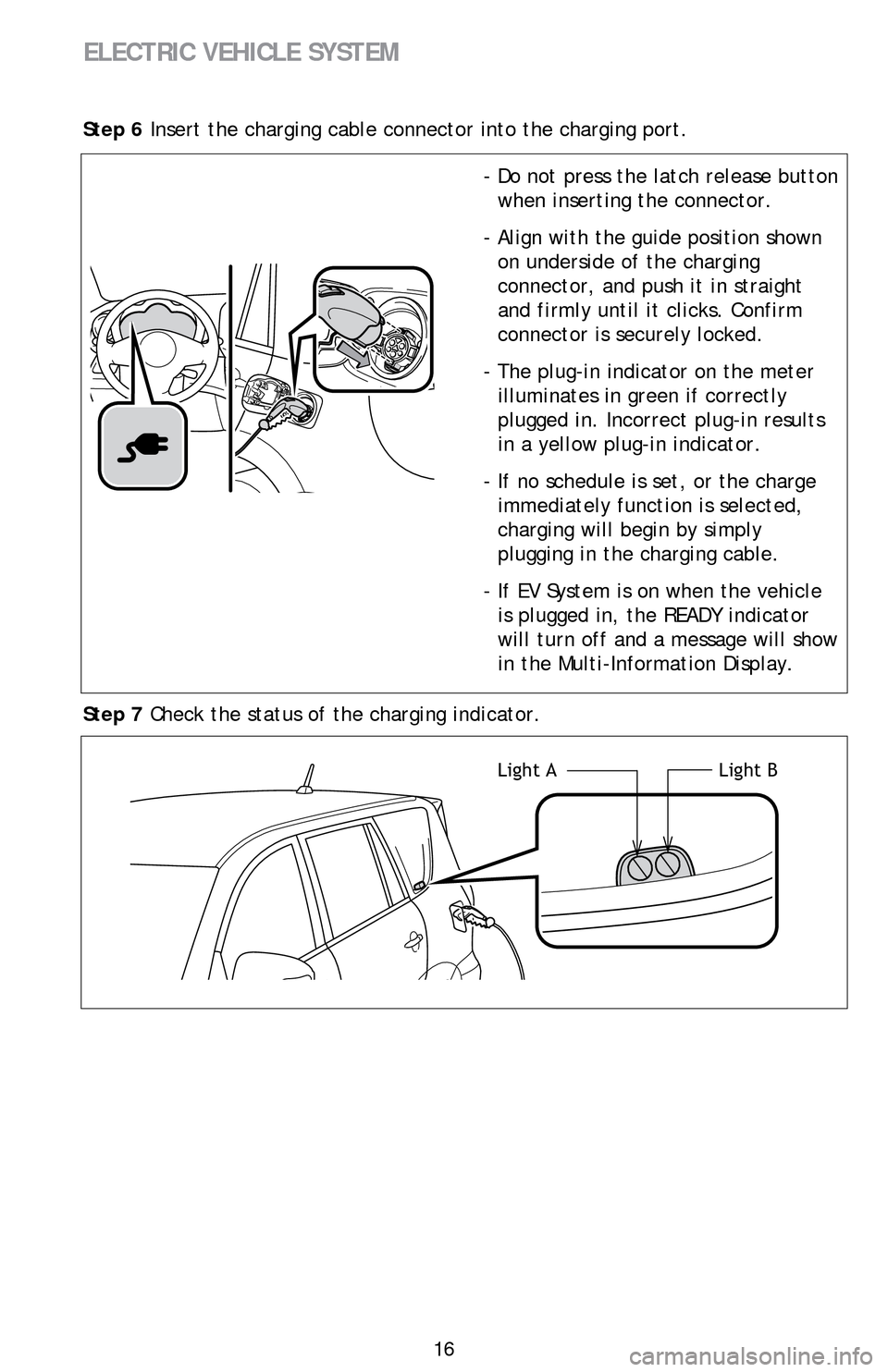
16
ELECTRIC VEHICLE SYSTEM
Step 6 Insert the charging cable connector into the charging port.
- Do not press the latch release button
when inserting the connector.
- Align with the guide position shown
on underside of the charging
connector, and push it in straight
and firmly until it clicks. Confirm
connector is securely locked.
- The plug-in indicator on the meter
illuminates in green if correctly
plugged in. Incorrect plug-in results
in a yellow plug-in indicator.
- If no schedule is set, or the charge
immediately function is selected,
charging will begin by simply
plugging in the charging cable.
- If EV System is on when the vehicle
is plugged in, the READY indicator
will turn off and a message will show
in the Multi-Information Display.
Step 7 Check the status of the charging indicator.
Light A Light B
Page 19 of 52
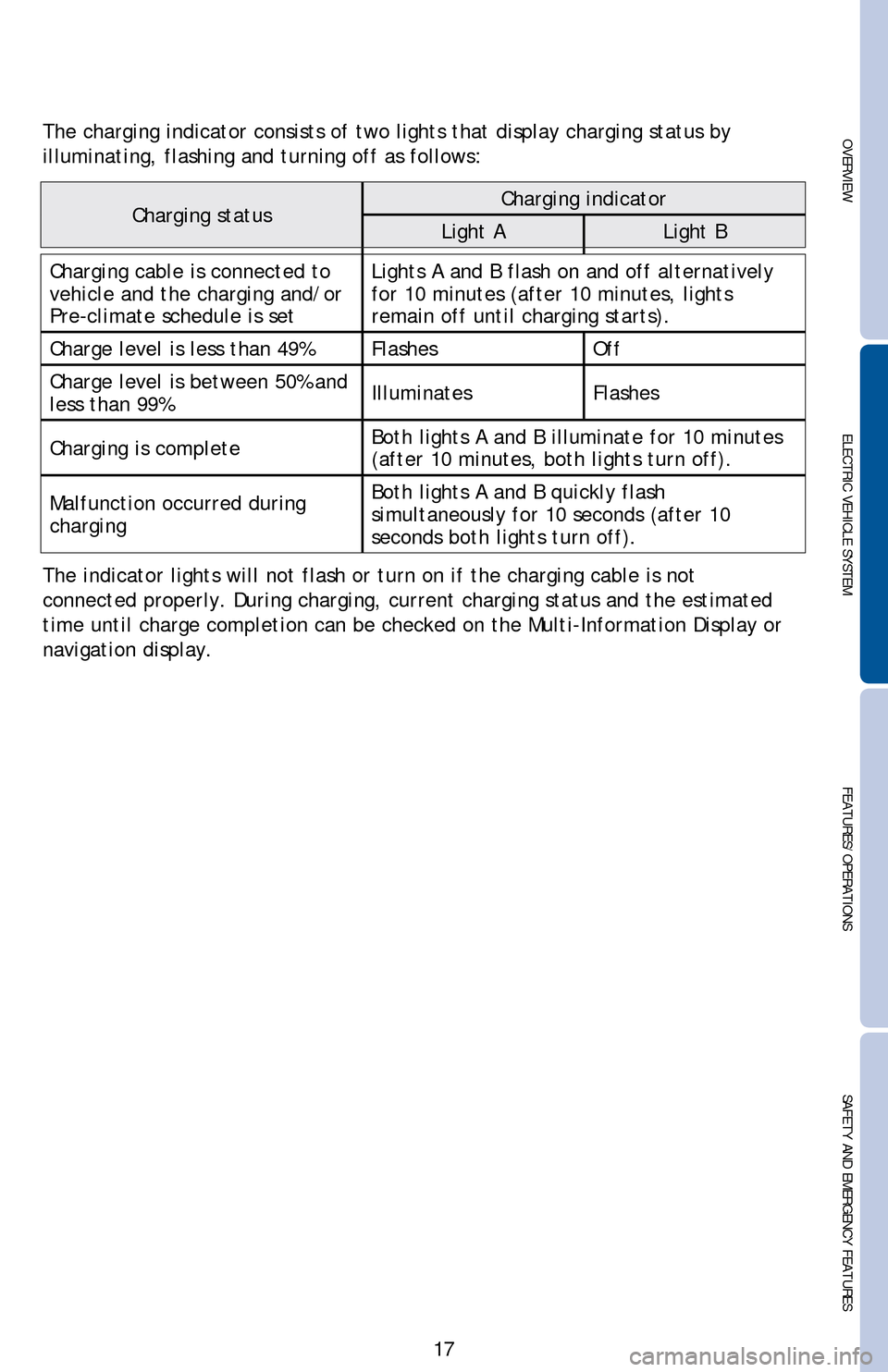
OVERVIEW ELECTRIC VEHICLE SYSTEMFEATURES/OPERATIONS
SAFETY AND EMERGENCY FEATURES
17
The charging indicator consists of two lights that display charging status by
illuminating, flashing and turning off as follows:
The indicator lights will not flash or turn on if the charging cable is not
connected properly. During charging, current charging status and the estimated
time until charge completion can be checked on the Multi-Information Display or
navigation display.
Charging statusCharging indicator
Light A Light B
Charging cable is connected to
vehicle and the charging and/or
Pre-climate schedule is setLights A and B flash on and off alternatively
for 10 minutes (after 10 minutes, lights
remain off until charging starts).
Charge level is less than 49% Flashes Off
Charge level is between 50% and
less than 99%Illuminates Flashes
Charging is completeBoth lights A and B illuminate for 10 minutes
(after 10 minutes, both lights turn off).
Malfunction occurred during
chargingBoth lights A and B quickly flash
simultaneously for 10 seconds (after 10
seconds both lights turn off).
Page 20 of 52

18
Charging cable-Unplugging
Step 1 Pull the charging connector toward you while pressing the latch release
button.
Step 2 Attach the charging connector cap.
ELECTRIC VEHICLE SYSTEM
Firmly push the charging port cap
and charging port door, and check
that they are securely locked. Step 3 Close the charging port cap, and then close the charging port door.
- Hold the body of the plug while
removing.
- Make sure to put the cable away
immediately after disconnecting.
- When leaving the plug inserted, check
the plug and connector once a month
for accumulation of dirt or dust. Step 4 Remove the plug from the electrical receptacle when the charging
equipment will not be used for a long period of time.